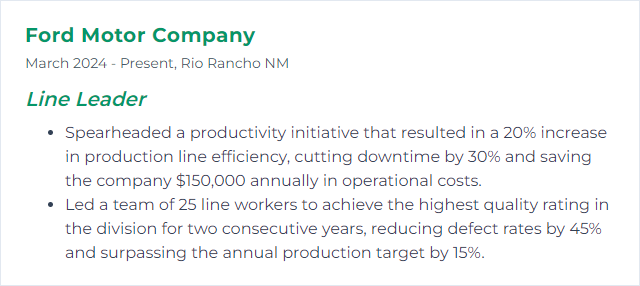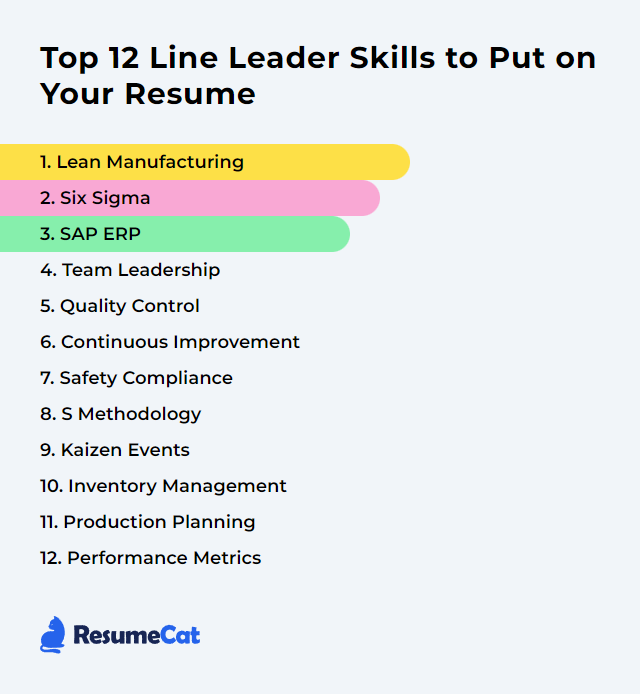Top 12 Line Leader Skills to Put on Your Resume
In today's competitive job market, standing out as a line leader means showing a sharp mix of leadership, process savvy, and relentless focus on flow. The right skills on your resume signal you can steer a line, squash waste, and keep quality tight—day after day.
Line Leader Skills
- Lean Manufacturing
- Six Sigma
- SAP ERP
- Team Leadership
- Quality Control
- Continuous Improvement
- Safety Compliance
- 5S Methodology
- Kaizen Events
- Inventory Management
- Production Planning
- Performance Metrics
1. Lean Manufacturing
Lean Manufacturing trims waste and amplifies value by tightening every step from materials to finished goods. As a Line Leader, you choreograph flow, protect quality, and keep people and equipment aligned to what matters most: customer value and on-time output.
Why It's Important
Lean drives down costs, shortens lead times, and boosts quality. For a Line Leader, it means smoother changeovers, fewer stoppages, and a team that solves problems before they snowball.
How to Improve Lean Manufacturing Skills
Kaizen every day: Encourage small, steady fixes. Make ideas easy to submit and quick to test.
5S the workspace: Sort, Set in order, Shine, Standardize, Sustain. Clean lines run faster and safer.
Value Stream Map: Visualize the end-to-end flow to spot delays, rework loops, and handoff friction.
Standard work: Document best-known methods. Train to them. Improve them. Repeat.
PDCA habit: Plan-Do-Check-Act to learn fast and lock in gains.
Visual management: Boards, andons, clear status at a glance. Make abnormal obvious.
Gemba time: Go see. Ask why. Show respect. Problems reveal themselves on the floor.
Do this consistently and the line gets lighter on its feet—quicker, calmer, more predictable.
How to Display Lean Manufacturing Skills on Your Resume
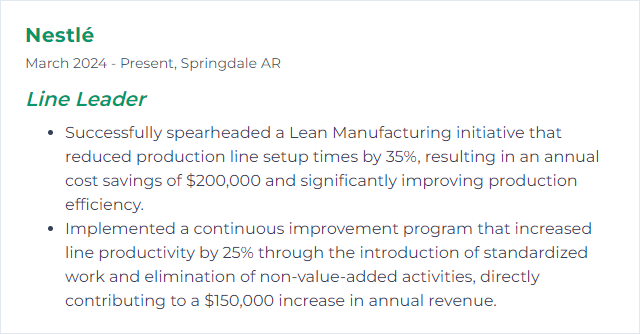
2. Six Sigma
Six Sigma hunts variation with data and disciplined problem solving, aiming for near-zero defects. On the line, it’s DMAIC in action—find root causes, tighten controls, and keep quality steady under pressure.
Why It's Important
Fewer defects. Lower cost. Happier customers. And for a Line Leader, clearer decisions backed by evidence, not guesswork.
How to Improve Six Sigma Skills
Work the DMAIC flow: Define tightly, measure rigorously, analyze causes, improve surgically, control what you changed.
Use the toolbox: Pareto, fishbone, 5 Whys, control charts, capability studies—pick the right blade for the job.
Baseline and verify: Trust clean data. Calibrate gauges. Validate results before scaling.
Hold the gains: Control plans, visual checks, mistake-proofing. Make backsliding hard.
Coach the team: Involve operators early. They see the edge cases.
How to Display Six Sigma Skills on Your Resume
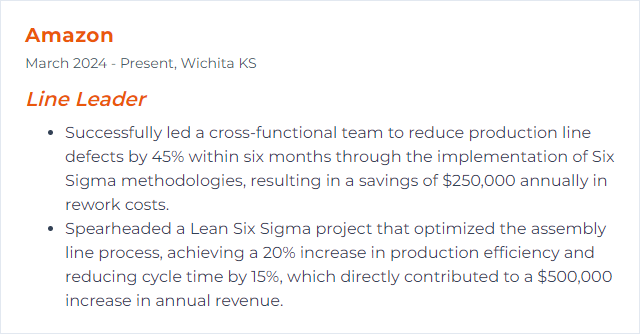
3. SAP ERP
SAP ERP connects production, materials, maintenance, and finance, giving you real-time insight and tighter coordination. For Line Leaders, it’s the system of record that feeds schedules, confirms output, and flags exceptions fast.
Why It's Important
Accurate data, fewer surprises, and smoother planning. Better signals in, better decisions out.
How to Improve SAP ERP Skills
Role-based training: Master the transactions and Fiori apps you touch daily—confirmations, goods movements, orders, and notifications.
Clean data discipline: Enforce accurate BOMs, routings, master data, and timely confirmations. Garbage in, chaos out.
Dashboards and KPIs: Surface line status, backlogs, and material shortages on one screen.
Workflow and alerts: Automate approvals, trigger notifications for variances, and escalate blockers.
Integrate with the floor: Sync with MES/barcoding to reduce manual entry and latency.
How to Display SAP ERP Skills on Your Resume
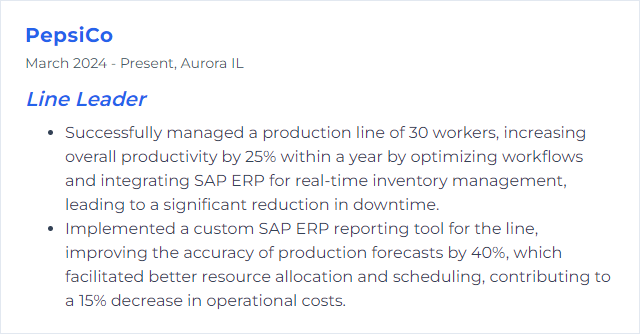
4. Team Leadership
Real leadership on a line looks like clarity, calm under stress, and steady communication. You set the tone, remove roadblocks, and grow people while you hit the numbers.
Why It's Important
Teams mirror their leader. A focused, supported crew moves faster, makes fewer mistakes, and sticks around.
How to Improve Team Leadership Skills
Set crisp expectations: Roles, targets, boundaries—no fog.
Coach in the moment: Quick feedback loops, specific, respectful, actionable.
Run tight huddles: Short daily standups, surface risks, assign owners, follow through.
Delegate with trust: Match tasks to strengths and let people own outcomes.
Resolve conflict fast: Facts first, then the fix. No festering.
Recognize wins: Public credit, private course-corrects. Morale matters.
How to Display Team Leadership Skills on Your Resume

5. Quality Control
Quality Control means detecting variation early and preventing defects from escaping. On the line, it’s standard methods, reliable checks, and quick containment when something drifts.
Why It's Important
Fewer reworks, less scrap, more trust from customers. And a calmer schedule that doesn’t whiplash around defects.
How to Improve Quality Control Skills
Lock in SOPs and checklists: Make the right way the easy way.
Use SPC where it counts: Monitor critical parameters with control charts; act on signals.
First-article and line clearance: Verify setups and handoffs before volume runs.
Calibrate and maintain gauges: Trust measurements or pause the line.
Clear defect handling: Contain, log, analyze, and prevent recurrence with mistake-proofing.
Close the loop: Feed field failures and customer feedback into process tweaks.
How to Display Quality Control Skills on Your Resume
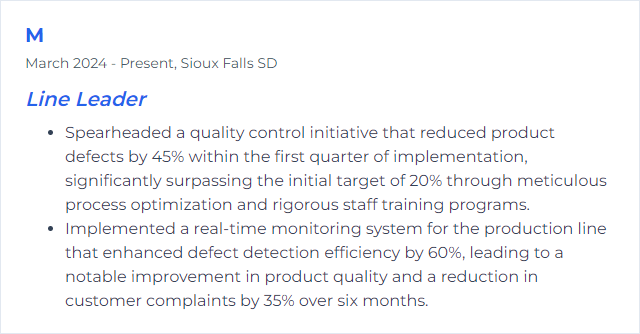
6. Continuous Improvement
Continuous Improvement is the drumbeat—small changes, every shift, stacked into big gains. Structure the habit and the upgrades never stop.
Why It's Important
Waste shrinks. Throughput climbs. People get engaged because they help shape the work they do.
How to Improve Continuous Improvement Skills
Idea system: Simple submission, fast trials, visible results.
PDCA and A3 thinking: Frame problems clearly, test countermeasures, reflect, standardize.
Metrics that matter: Tie improvements to flow, quality, safety, and cost—not vanity counts.
Rapid experiments: Time-box trials; learn more than you plan.
Standardize the win: Update SOPs and training so gains stick.
How to Display Continuous Improvement Skills on Your Resume
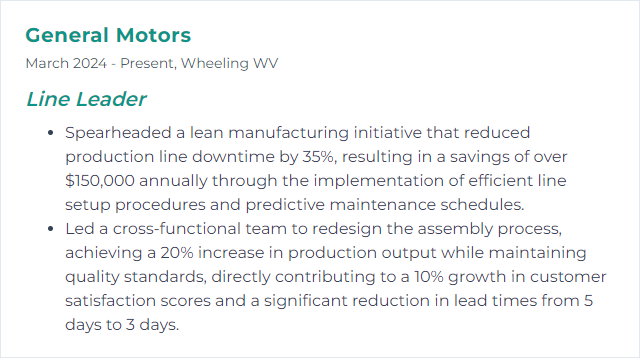
7. Safety Compliance
Safety compliance is non-negotiable. It’s procedures, training, and culture that keep everyone going home in one piece.
Why It's Important
Prevents injuries, limits downtime, reduces legal risk—and builds trust on the floor.
How to Improve Safety Compliance Skills
Train and refresh: Job-specific hazards, lockout/tagout, PPE, emergency drills—repeat often.
Toolbox talks: Short, frequent briefings with real examples from your line.
Near-miss culture: Make reporting simple, blame-free, and acted upon.
Frequent audits: Walk the line with a checklist; fix unsafe conditions immediately.
Ergonomics first: Adjust stations, reduce lifts and twists, rotate tasks to protect people.
How to Display Safety Compliance Skills on Your Resume

8. 5S Methodology
5S is the backbone of a tidy, fast, and safe line: Sort, Set in order, Shine, Standardize, Sustain. Order reduces friction; clarity speeds decisions.
Why It's Important
Less time hunting, fewer errors, faster changeovers, safer stations. Everything in its place, every time.
How to Improve 5S Methodology Skills
Sort hard: Remove the nonessential. Space is precious.
Set in order: Label, color-code, shadow-board tools. First-time-right retrieval.
Shine daily: Clean as inspection. Dirt hides defects.
Standardize visuals: Common layouts, markings, and checklists across shifts.
Sustain with audits: Regular checks, rotating owners, visible scores, quick fixes.
How to Display 5S Methodology Skills on Your Resume
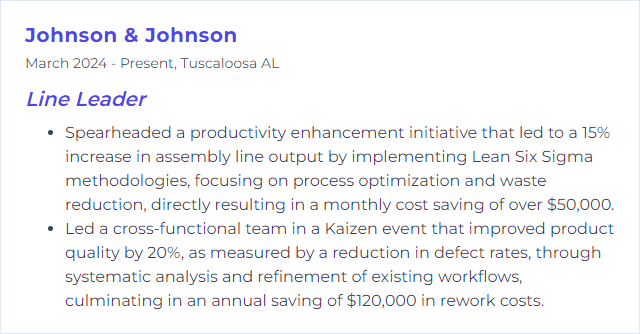
9. Kaizen Events
Kaizen events are intense, short bursts aimed at a focused problem. Cross-functional team, rapid analysis, implement now, verify fast.
Why It's Important
Quick wins stack up. Bottlenecks shrink. Teams learn to solve together—and the energy carries forward.
How to Improve Kaizen Events Skills
Prep is everything: Tight scope, clear target, right data, right people.
Use the right tools: Value stream maps, SMED, spaghetti diagrams, 5 Whys—deploy as needed.
Implement during the event: Pilot changes on the spot to prove the gains.
Assign owners: Each action with a name, date, and success measure.
Follow up hard: 30/60/90-day checks to confirm sustainability.
How to Display Kaizen Events Skills on Your Resume

10. Inventory Management
Inventory management balances availability with cash and space. The right parts, right quantity, right time—without bloat.
Why It's Important
Prevent line stoppages, trim holding costs, and keep accuracy high so plans don’t crumble.
How to Improve Inventory Management Skills
Forecast and align: Tie demand signals to reorder points and safety stock.
ABC and cycle counts: Focus checks on high-impact items; count often, in small bites.
Kanban flow: Visual pull systems to smooth replenishment and avoid overstock.
Tight supplier rhythm: Clear lead times, minimum order quantities, and delivery cadence.
FIFO/FEFO discipline: Rotate stock to prevent aging and scrap.
System accuracy: Real-time transactions, barcode scanning, and clear ownership of moves.
How to Display Inventory Management Skills on Your Resume
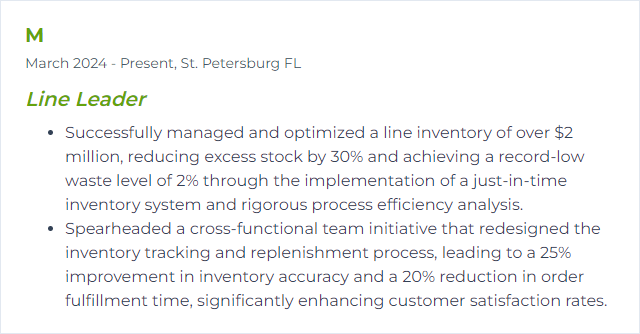
11. Production Planning
Production planning lines up people, machines, and materials against demand. It’s scheduling with reality in mind—capacity, constraints, and changeovers.
Why It's Important
Strong planning cuts costs, improves on-time delivery, and calms the daily firefight.
How to Improve Production Planning Skills
Forecast with feedback: Blend historicals with real-time demand; refresh often.
Finite scheduling: Respect true capacity and constraints; don’t double-book assets.
Takt and level-load: Match pace to demand and smooth the mix to reduce peaks.
Shorten changeovers: SMED tactics to free capacity and shrink lots.
Plan materials tightly: Align MRP signals, safety stocks, and supplier lead times.
Cross-train: Flex people across stations to absorb variability.
Real-time updates: Visual boards and alerts to adjust quickly when plans shift.
How to Display Production Planning Skills on Your Resume
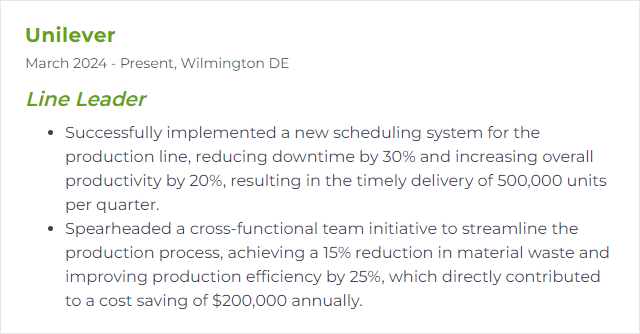
12. Performance Metrics
Metrics make performance visible. For a Line Leader, that means tracking throughput, quality, uptime, and safety with numbers the team can act on.
Why It's Important
What you measure improves. Metrics align effort, expose drift, and power decisions.
How to Improve Performance Metrics Skills
Pick the vital few: OEE, first-pass yield, scrap, on-time delivery, schedule adherence—choose what moves outcomes.
Set baselines and targets: Know today’s truth, then stretch responsibly.
Build a simple dashboard: Real-time, visual, and at the point of use.
Review rhythm: Tiered daily/weekly reviews with clear owners and actions.
Drill into root causes: When numbers wobble, investigate fast and fix at source.
How to Display Performance Metrics Skills on Your Resume
